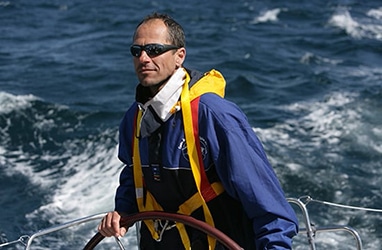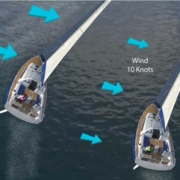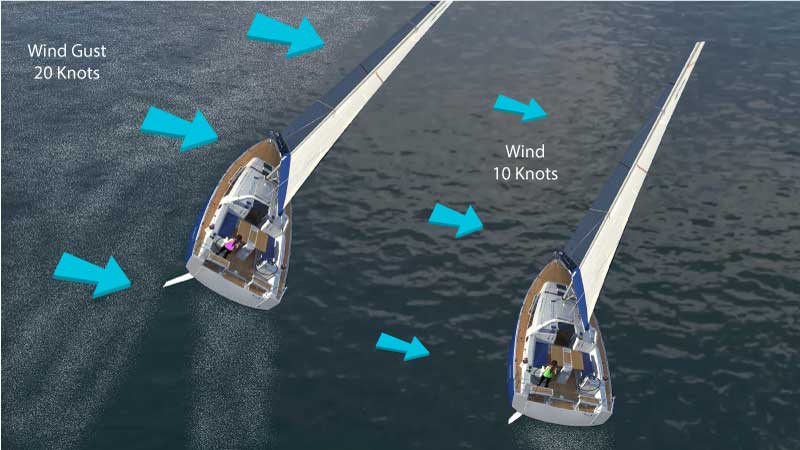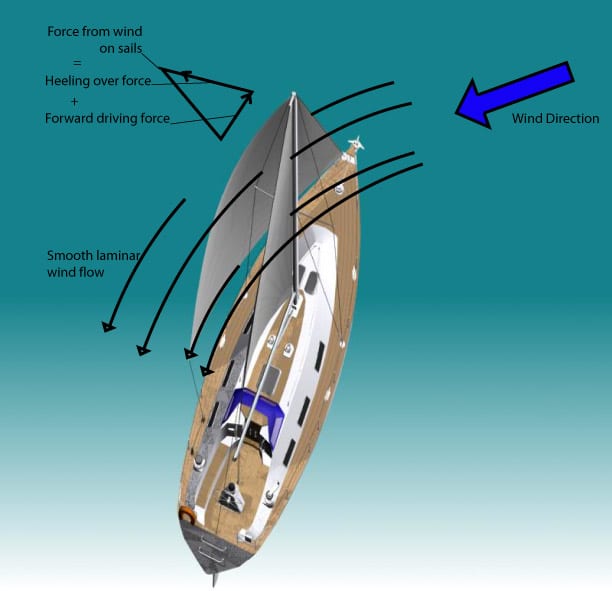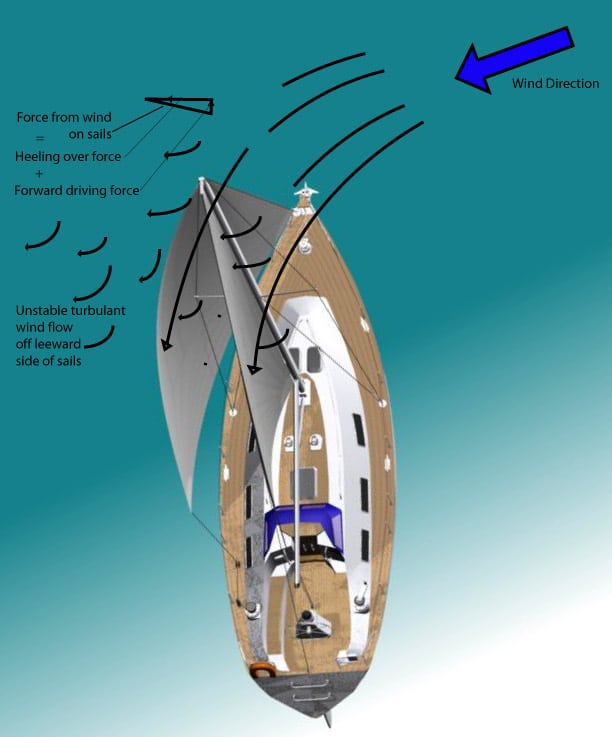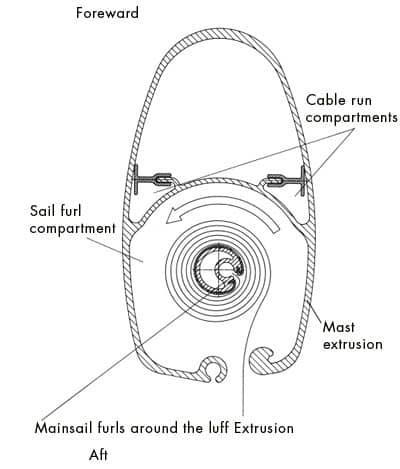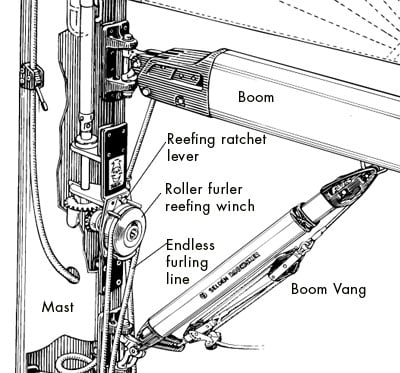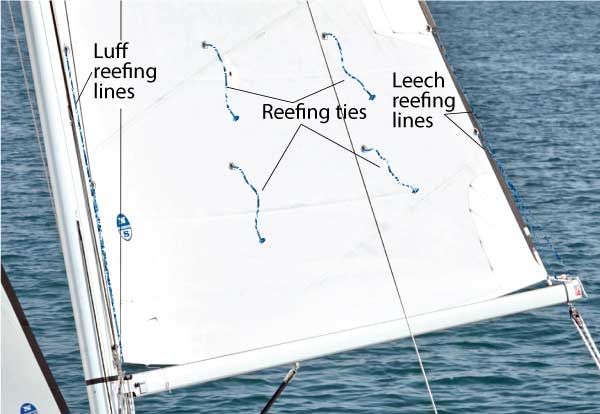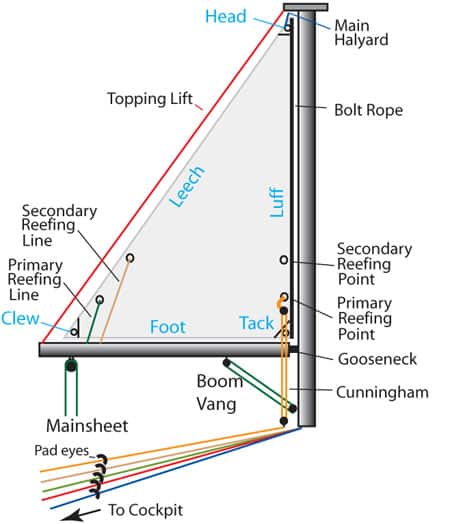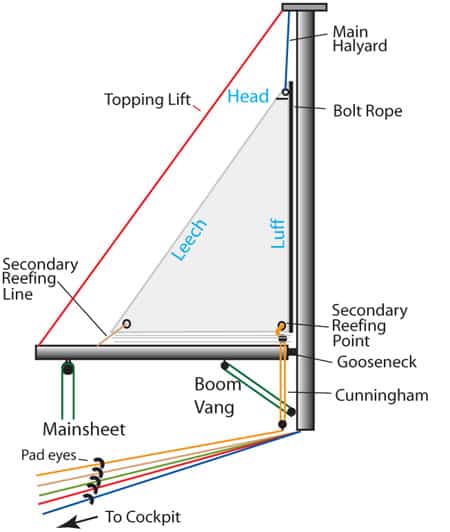Reefing the Sails
Heave ToIt is time for a voluntary break. From time to time, we hand-pick videos from YouTube Channels that we follow and like to place in appropriate places in our course. You’re welcome to skip this if you are powering through but sometimes you need to give your brain a rest and see the WHY of your work here. In this video, watch our friends Tom and Peter from Sailing Bohemia power through some serious wind and why they reefed their sails early. If you liked this, subscribe to Sailing Bohemia Channel – and buy them a drink using Patreon. Believe me – after that trip, they needed one! Now, back to work! End Heave To |
Before heading out, check forecasted wind conditions to see if you might need to reef at some point during the day. If so, make appropriate preparations in the calm marina and ensure your crew knows the procedure.
It is important to realize that you are not necessarily going fast when heeling excessively, though you might think you are. To the contrary, you will slow down under such conditions. The following image shows a boat being excessively heeled over as a gust comes through It is uncomfortable for the crew and it puts excessive strain on the rig and makes the boat go slower because the wind is stalling on the backside of the sail. To speed up the boat you need to reef the sail.
In gusty conditions, reefing is the prudent thing to do.
Over Heeling
Air Flow
The following illustrations show how the smooth flow of air (called laminar flow) over a sail creates a forward force and heeling force. Smooth airflow is created when the sails are trimmed correctly. As the wind flows around the leeward side of the sail it bends and “stays attached” to the sail shape.
Laminar Flow Attached
When you ask the wind to bend too much, it will spawn and create turbulence. This reduces the effect of the sails and slows the boat. The higher the velocity of the wind, the less the wind tends to bend. This is one of the reasons why in high wind conditions you need to reduce the size of the sail. Since the sail is smaller when reefed, the wind is required to bend less over the distance from the front (luff) of the sail to the back (leech) of the sail, and therefore the wind will not break away from the sail as much. Once the wind breaks away from the low-pressure side, as, in the diagram below, you’re reducing efficiency. In the same way, an airplane will stall. When the flow of air breaks away from the top side of the wing, lift is lost and the plane quickly aims itself at the ground. In sailing, the result is less dramatic. Simply let the sail out and the wind will reattach to the leeward side of the sail.
Reefing—reducing sail area—should begin at or around 12 to 16 knots of wind. Reefed sails reduce the heeling over force from the wind and help the wind stay attached to the leeward side of the sail, thus reducing the turbulent inefficient flow of wind.
Turbulent Flow Detached
Reefing Roller-Furling Sails
Reefing using roller-furler sails is by far the easiest way of reefing. You simply wind up the sail until you are satisfied with the sail size. Here is a basic animation.
Roller Furling Reefing
In general, for your first reef at about 12 to 16 knots, you should furl up the sail about 18 inches (45 centimeters). Around 18 to 22 knots, you’ll need another reef; for this second reef, you should furl in the sail another 18 inches (45 cm). As you gain experience with your boat, you’ll get the feel for how much to reef in. Essentially, if your boat is heeling over a lot, you’ll need to reef in more.
So which sail do you reef first? The headsail or the mainsail? The answer is pretty complex and involves the design of your boat and rig. When you reef a sail you are moving the center of pressure point that the wind acts on the sail relative to the boat. That is, making the triangle smaller moves the center of that triangle forward on the boat. This affects the dynamic relationship between the rudder, the keel, and the sails.
In a practical sense then, test out your boat’s behavior by reefing the different sails in different orders on a windy day (with minimal gusts) and feel the changed pressure on the rudder. As a novice sailor, this is going to be hard. As you gain more experience you’ll feel the difference. We say all this to ward off the concept of a formula of which sail to reef first. The process is dynamic. Given all that, if you are just starting out, primarily all you are trying to do is reduce heeling and reduce the forces on the rig. So start by reefing the mainsail, then move on to the headsail.
The below illustration shows the mast extrusion and how the sail is rolled up into the mast.
Roller Furler Mast Extrusion
The next illustration shows the Selden roller furler ratchet system. By turning the reefing winch, the sail winds up inside the mast. The endless furling line allows the crew to turn the reefing winch from the cockpit. The ratchet lever will prevent the sail from unwinding. Thus, to unfurl the sail, the ratchet level must be set to “free.”
Both illustrations are courtesy of Selden.
Roller Fuller System
Traditional Reefing Systems
A traditional mainsail system does not have a mast furling mainsail. Rather, the mainsail must be hoisted up with the main halyard to begin sailing. When reefing, the mainsail must be lowered to reduce its sail area.
Below is a basic animation. It shows replacing the number 1 headsail with a number 3 headsail, which is smaller. It also shows lowering the mainsail to the predetermined reefing points. From the above discussion on which to reef first, the order in the animation does not show the order of reefing. As we said above, this depends on the boat and rig.
With headsails that are hoisted as opposed to furling, you can’t reef. Rather, you change out the sail for a smaller one.
Reefing Animation
To Reef the Mainsail
At the front (luff) of the sail, there are usually two reefing points, the first and second (aka primary and the secondary). The primary is the first reef you’ll put in for wind speeds of approximately 12 to 16 knots. The secondary reef will need to be put in at about 18 to 22 knots.
You can reef the mainsail while sailing with just the headsail. Here is the procedure:
- Decide if you are going to use the primary or secondary reefing points.
- Check the boom topping lift so that when you ease the halyard down the boom does not drop completely into the cockpit.
- Ease the mainsheet so there is no load on the sail from the wind.
- Optionally, over-tighten the headsail sheet so as to back-wind the mainsail. This reduces wind loading on the mainsail.
- Ease the main halyard so that the reefing point is just higher than the boom.
- Place the cunningham hook into the reefing point and tighten it so that the reefing point is brought down to the boom level (lowering the sail).
- At the leech of the sail, the corresponding reefing must also take place
- Trim both sails.
The leech reefing lines may be secured at the aft of the boom or they may run down to the boom, travel forward inside the boom, down the mast, and back along the deck through a series of pad eyes to the cockpit. Pulling in on the appropriate reefing line will lower and thus reef the leech of the sail.
A convenient set-up on some reefing systems is a single-line reefing system. With a single-line reefing system, one line acts to pull down both the luff and leech of the sail simultaneously. Here is a video from Selden Masts showing a single-line reefing system. If you have one installed on your boat, you will love how easy it is to reef.
Single Line Reefing System
Whenever you are reefing the mainsail, observe the boom topping lift line and the main sheet and ensure that they are not tight, otherwise, these will interfere with your ability to tighten the leech reefing lines.
The holes in the sail at the reefing points are called cringles. In some cases, there are additional cringles in the center of the sail between each reefing point. Small reefing tie lines go through these cringles to secure the sail to the boom when it is reefed.
Reefing Ties
“Shaking Out the Reef”
Releasing the reefing lines and raising the sail back up fully is called “shaking out the reef.” Here’s how:
- Ease the mainsheet
- Undo any reefing ties in the center of the sail
- Ease the cunningham completely and remove the hook
- Ease the leech reefing lines
- Raise the mainsail halyard
- Trim the mainsail
- Check topping lift is loose
The following illustration shows many of the components of the sail and the traditional reefing system.
Sail Components
The following shows the same sail reefed to the secondary reefing position.
Sail Reefed
When reefing, you do one sail at a time. You can reef the boat while still under sail with the other sail still propelling the boat. A close haul is best. Heading to wind is an option but all the sails begin to flap wildly, which can be dangerous because of the whipping sheets.
In heavy weather, reefing usually requires someone to go forward to the cockpit. Ensure this person is harnessed to the jacklines, and safety lines connected to the deck running the length of the boat.

